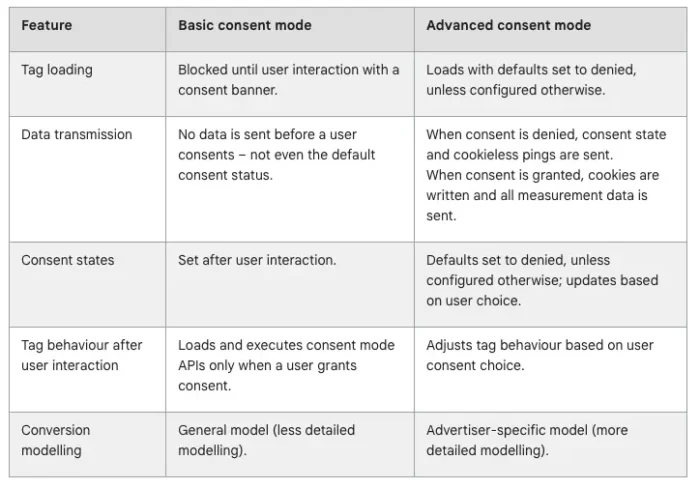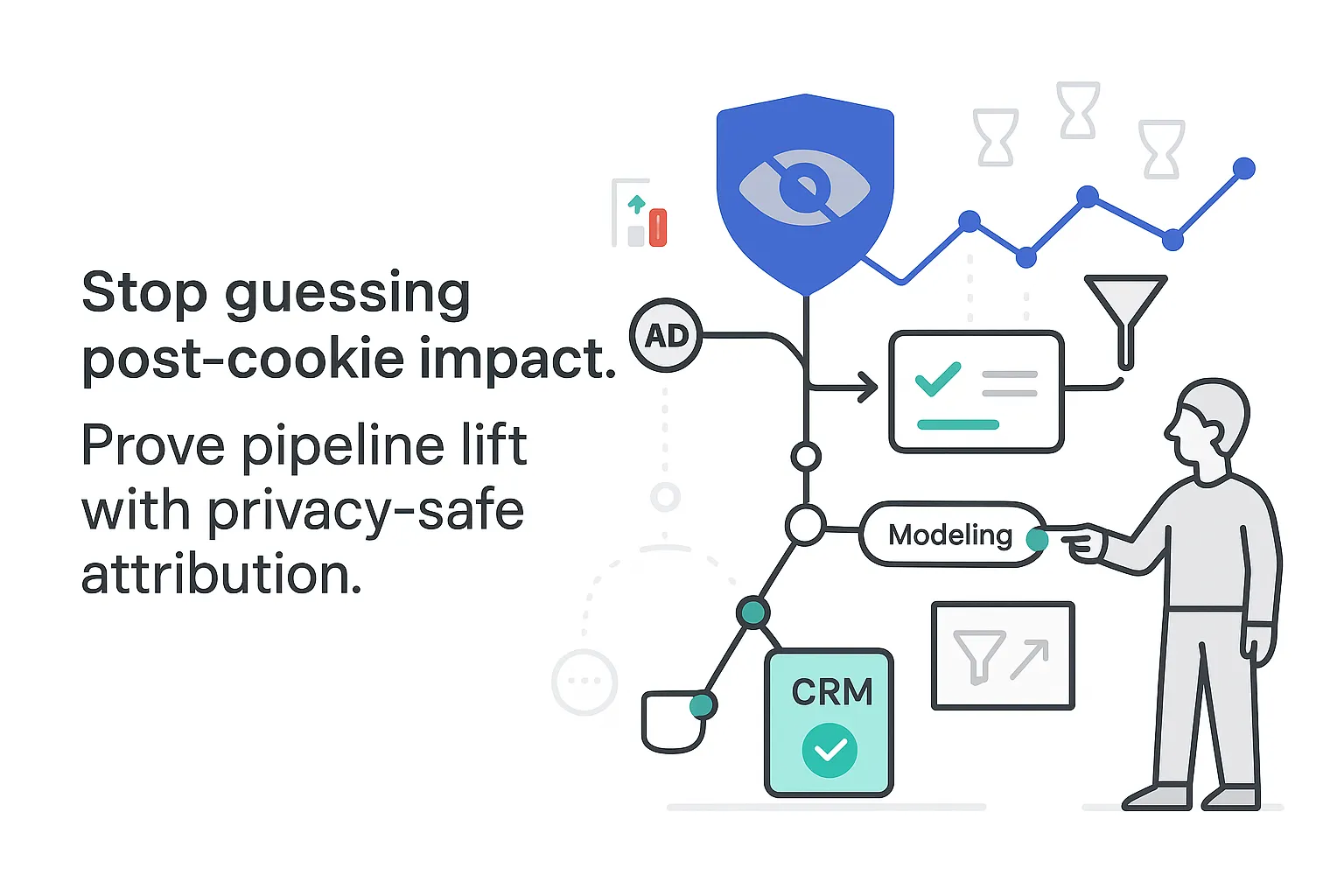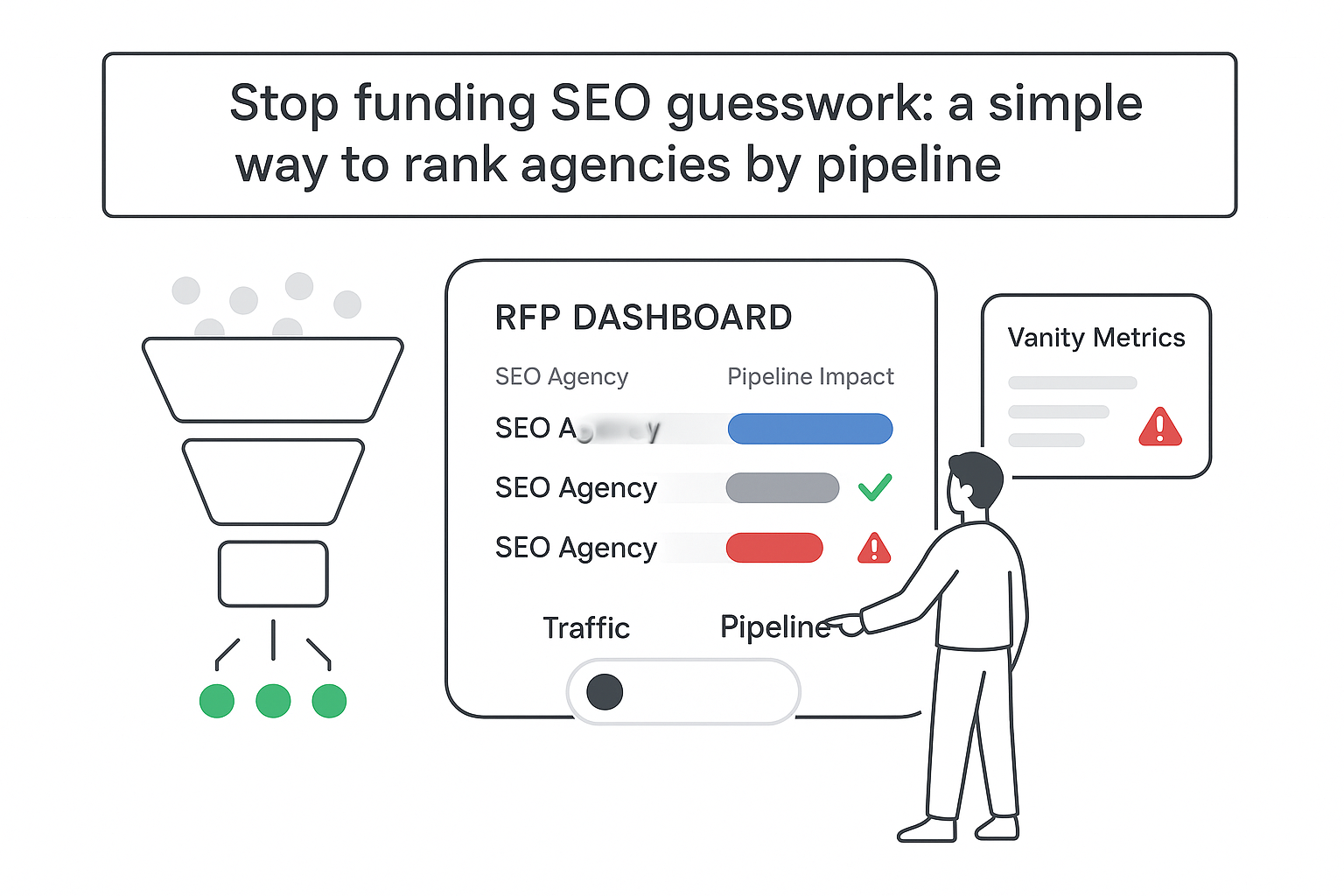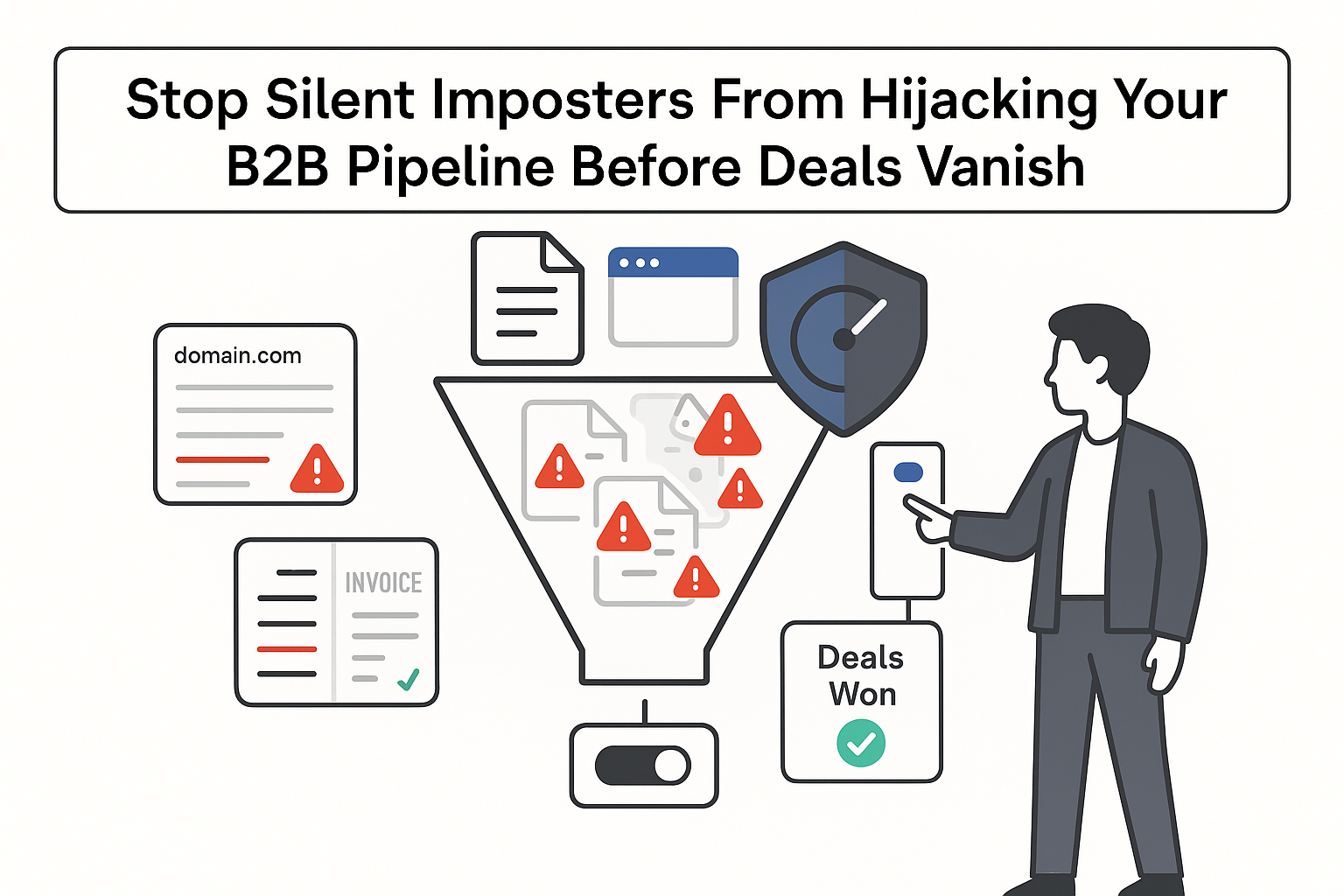The measurement game is changing. If I run a B2B service company, I need clean signals about which channels bring qualified leads and real pipeline, even as third-party cookies fade into the background. My goal isn’t perfect tracking; it’s confident decisions. That means a privacy-aware setup that ties ad clicks to CRM outcomes, fills gaps with modeling, and cross-checks results with experiments. It sounds like a lot; it isn’t once I stack it in the right order.
Cookieless attribution
Cookieless attribution assigns credit to marketing touchpoints without relying on third-party cookies. For a B2B service motion, the point is simple: I want to understand which channels and messages produce quality leads, sales-qualified leads (SQLs), and revenue, while respecting user privacy and platform rules. Instead of long user-level paths stitched across sites, my measurement shifts toward first-party IDs, modeled conversions, and channel-level lift.
I still answer the questions that matter. Which keywords fill the pipeline. Which audiences produce higher average contract value (ACV). Which social placements lift mid-funnel engagement that sales can feel. The methods change, not the mission.
TL;DR
- My minimum viable stack: first-party data capture, modeled conversions, marketing mix modeling (MMM) calibrated with experiments, and limited multi-touch attribution (MTA) on consented users.
- I focus attribution around CRM stages I trust: marketing-qualified lead (MQL), SQL, opportunity, revenue.
- I treat GA4 and the data warehouse as the source of truth for behavior, and the CRM as the source of truth for money.
- I build a measurement ladder: experiments, then MTA on first-party data, then MMM.
Cookies in tracking for post-cookie marketing measurement
Here’s how I frame cookies. Cookies are small files set in the browser. First-party cookies are set by my own domain to keep sessions together, remember preferences, and support analytics. Tools like Google Analytics 4 use first-party cookies. Third-party cookies are set by other domains and historically supported cross-site tracking and retargeting at scale. Safari’s ITP and Firefox’s ETP already cut off much of that. Chrome continues to tighten how third-party cookies work with privacy controls and sandboxed APIs such as Privacy Sandbox and has adjusted timelines via its official blog post, under ongoing scrutiny by the UK’s Competition and Marketing Authority (CMA).
What actually breaks or shrinks as third-party cookies fade: cross-site retargeting volume, cross-site frequency capping, and deterministic user-level paths that follow a person around the open web. What keeps working: first-party analytics, modeled conversions in ad platforms, and CRM-based offline conversions.
For B2B, my CRM reduces reliance on third-party identifiers. If my flow is ad click → content → demo request → qualification in the CRM, I can pass hashed emails, gclid or other click IDs, and conversion timestamps back into ad platforms as offline conversions. That keeps optimization focused on sales outcomes rather than simple form fills.
Why third-party cookies are going away for privacy-first advertising measurement
Three drivers pushed the shift. First, regulation. GDPR in Europe and CCPA/CPRA in the United States set consent and data-use limits. Second, platforms. Apple’s AppTrackingTransparency reduced mobile tracking across apps, and browsers followed with tighter cookie controls. Third, people. Users expect choice, clear value exchange, and less stalking.
So what changes for B2B marketers in practice:
- Retargeting scale falls, so creative, context, and offer quality carry more weight.
- Cross-site frequency capping gets noisy, so I watch reach and frequency inside each walled garden.
- Deterministic, user-level paths across the open web become less common, so I plan for modeled and aggregated answers.
What stays workable:
- First-party cookies and consent-based identifiers.
- Modeled conversions tied back to verified CRM outcomes.
- Experiments that measure lift, even when user-level stitching is incomplete.
How marketing without cookies works with MTA without third-party cookies
I think of a privacy-safe stack as layers that pass only what’s needed, with consent.
- Consent management. A consent management platform (CMP) records user choices and sets lawful bases for data collection.
- Server-side tagging. I move tags from the browser to a server I control. This raises data quality and keeps collection in a first-party context. See Google’s overview of server-side tagging.
- Enhanced Conversions or Conversions API. Google Ads Enhanced Conversions, Meta Conversions API, and LinkedIn’s conversions API accept hashed identifiers and conversion details I send after a form submit is verified in my CRM.
- GA4 and BigQuery. GA4 collects first-party events, models gaps, and exports to BigQuery. That export is where I connect ad costs, site behavior, and CRM outcomes.
- CRM integration. I map leads to campaigns, ad groups, and even keywords using click IDs and disciplined UTM governance.
- Clean rooms. I use secure environments (for example, platform-native clean rooms) to match aggregated performance with first-party data without sharing raw user-level records.
- Modeled conversions. I accept that some conversions are inferred. Models fill blind spots where consent or platform signals are missing.

A simple B2B flow I can run:
- A prospect clicks a LinkedIn ad and lands on a guide. I ensure GA4 records the session using first-party cookies.
- They submit a demo form. My form captures consent, email, and a hidden field with the click ID and UTMs.
- The lead syncs to the CRM. An SDR qualifies it. When the stage reaches SQL or Opportunity, my server posts an offline conversion to the ad platform with the original click ID and a value.
- GA4 sends events to BigQuery. My model joins ad spend, site behavior, and CRM stages, then feeds reporting and bidding via APIs.
- Where identity is probabilistic (for example, hashed email matches across devices), I treat results as directional. Where data is aggregated, I use channel-level models and experiments as guardrails.
Common attribution models and aggregate vs user-level attribution
Rules-based models still have a place. First-click helps me see who starts the journey. Last-click helps me protect bottom-funnel efficiency. Linear, time-decay, or U-shape spread credit to match a longer B2B path. Data-driven attribution (DDA) in GA4 or ad platforms uses observed behavior and models to distribute credit across interactions; its quality depends on volume, consent rates, and signal integrity. Marketing mix modeling (MMM) analyzes channels and spend at an aggregate level rather than per user. For definitions and options, see Google’s attribution modeling documentation.
How I apply them post-cookie:
- I use rules-based models for quick reads and channel hygiene.
- I use lightweight MTA on consented traffic inside GA4 or a clean room for tactical questions such as which creative or keyword pattern is driving qualified leads this month.
- I use MMM for channel budgets, reach questions, diminishing returns, and seasonality effects.
For B2B cycles with sales assist and offline steps, triangulation is the move. I pair a bottom-funnel view (for example, last non-direct click to SQL) with an aggregate model and a rolling set of experiments. I keep an eye on over-credit to brand search and direct; both tend to steal credit from upper-funnel channels.
I improve model accuracy by calibrating MMM with experiments. I run geo splits or holdouts, measure lift, and use that lift to tune the model so it matches observed reality.
MMM vs MTA comparison
Both answer “what is working,” yet they do it at different levels and speeds. A quick read:
- Granularity. MTA looks at user-level or session-level paths where consent allows. MMM looks at channels and spend at an aggregate level.
- Bias. MTA is prone to last-touch and brand-term bias if clicks cluster near conversion. MMM can smooth out short-term noise but may undercount small yet mighty tactics.
- Sample needs. MTA needs enough consented traffic to spot patterns. MMM needs stable spend and at least 8–12 weeks of data per channel to fit well.
- Speed. MTA can update daily. MMM usually runs monthly or quarterly, depending on volume.
- Hybrid. I keep a lightweight MTA on logged-in or consented users and run MMM quarterly. I use tests to reconcile the two.
Where each shines:
- MTA is useful for tactical choices such as “Which message drives booked calls from paid search this week?” or “Which audience tightens lead quality on LinkedIn?”
- MMM guides budget-shift questions such as “How much more pipeline comes from raising YouTube and retargeting spend by 20 percent in Q4?”
Pitfalls to watch:
- Deduping conversions across platforms is tricky. I align dedupe rules, pass a unique conversion_id with timestamps, and avoid counting the same offline conversion twice.
- I avoid all-or-nothing credit to brand search. I use negative keyword reviews and brand vs non-brand splits to keep it honest.
When stakeholders ask for a single truth, I remind them: marketing mix modeling vs multi-touch attribution isn’t a fight. It’s a partnership where aggregate and user-level views meet in the middle.
Challenges of attribution in a cookieless world and incrementality testing vs attribution
Some hurdles are technical. Some are human. All can be managed with a clear plan.
- Cross-device fragmentation. Prospects bounce from mobile to desktop to a personal email account. Mitigation: I collect consented identifiers, use hashed emails where allowed, and focus reporting on channel and audience rather than individual stitching.
- Walled gardens. Platforms measure inside their walls and claim credit. Mitigation: I set up offline conversions and run lift tests. I compare claimed results to my CRM.
- Modeled conversions uncertainty. Models help, yet they add variance. Mitigation: I report ranges where needed and use experiments to cross-check.
- Signal loss for retargeting. Smaller audiences mean fewer repeated touchpoints. Mitigation: I shore up creative and context, and lean on content that earns the second visit without retargeting.
- Long sales cycles and offline touches. SDR calls, meetings, and proposals are often invisible to ad platforms. Mitigation: I map CRM stages to offline conversions and send value-based signals back to platforms.
- Small samples in niche B2B segments. A dozen SQLs can swing a month. Mitigation: I use longer windows for measurement, aggregate by theme, and apply MMM to spot directional patterns.
A helpful framing: incrementality testing vs attribution. Attribution assigns credit to touches along the path. Incrementality testing measures causal lift with holdouts, geo splits, or PSA tests (public service announcement ads to measure baseline behavior). I need both. Tests ground my models in reality. Models extend what I learn across time and channels.
Privacy-first advertising measurement
I turn solutions into a staged plan I can run this quarter and next. I start with the layers I control, then add modeling where signals thin.
- Consent and governance. I deploy a CMP that captures consent and stores it. I set clear UTM rules and event names so my data stays consistent.
- Server-side tagging. I move GA4 and ad platform tags to a server container. This improves data quality and keeps data in a first-party context. Reference: GTM’s server-side tagging guide.
- GA4 plus warehouse. I export GA4 to BigQuery. I join ad cost imports, CRM stages, and product or service lines. I build a stable measurement table with one row per conversion event and the matching cost context.
- Offline conversions. I send SQL, opportunity, and revenue events back to Google Ads, Meta, and LinkedIn with values. I use their enhanced or API-based conversions to close the loop.
- MTA where allowed. I maintain MTA without third-party cookies by modeling paths on consented users only. That can happen inside GA4, a clean room, or my warehouse where I have hashed IDs and lawful bases.
- MMM for budget. I run an MMM that handles channel spends, reach, seasonality, and saturation. A Bayesian or regularized approach can stabilize estimates when samples are small or noisy.
- Guardrails. I set rules that stop models from overfitting. I keep simple baselines in view, such as last non-direct click to SQL, to sanity-check big swings.
Rollout guide:
- Hygiene month. I fix UTMs, event names, and CRM fields. I turn on server-side tagging for GA4 and my main ad platforms.
- Signal month. I start offline conversion uploads for at least one platform. I enable enhanced or API-based conversions everywhere I can.
- Model month. I launch a first MMM read with 12 to 24 weeks of data. I keep MTA for consented users to answer tactical questions.
- Test month. I run two lift tests - for example, a geo split for paid social and a brand vs non-brand search budget split - and use results to tune my model.
Tips for post-cookie marketing measurement
Here is a practical set of moves that tie measurement to B2B lead quality rather than surface clicks.
- Rethinking PPC. I configure enhanced/API conversions. I import offline conversion events with values tied to SQLs or revenue. I use value-based bidding like Smart Bidding. I test broader targeting once my signals are clean, and I let context, placements, and copy do more of the heavy lifting where retargeting shrinks.
- Analytics hygiene. I lock in event naming and UTM standards. I define dedupe rules across platforms. I turn on GA4 BigQuery export and schedule cost imports from Google Ads, Meta, and LinkedIn.
- Experiments. I run channel holdouts, geo splits, or PSA tests to measure lift. I keep a planned brand vs non-brand spend split in search and review it monthly. I use these tests to confirm what my models say.
- Reporting. I unify CAC, cost per qualified lead, pipeline, and revenue contribution by channel. I build a simple view that aligns MMM, MTA, and experiment readouts. When they disagree, I trust experiments first, then use models to explain the why.
FAQs
A quick set of straight answers, without fluff.
Is attribution still possible without third-party cookies?
Yes. I use a hybrid approach: first-party data, modeled conversions, MMM, and experiments, plus a lightweight MTA on consented users for tactical decisions.
What’s the difference between MMM and MTA?
MMM is aggregate and strategic, great for budget planning. MTA is user-level or session-level and tactical, ideal for creative and keyword choices. I use both and reconcile them with tests.
Can GA4 replace third-party cookies?
No. GA4 uses first-party cookies and modeled data. It can measure a lot when combined with server-side tagging and offline conversions, but it isn’t meant to bring back cross-site tracking.
How do I track PPC ROI now?
I use enhanced/API conversions, import offline conversion events tied to SQLs and revenue, run lift tests to validate signals, and optimize to qualified leads and actual pipeline - not just raw form fills.
What is incrementality testing vs attribution?
Attribution assigns credit across touches. Incrementality testing measures causal lift with holdouts or geo splits. I use tests to validate models and to find hidden waste.
How do first-party data attribution strategies work?
I capture consented identifiers, enrich leads with UTMs and click IDs, and connect my CRM to ad platforms and analytics via secure uploads or APIs. I pass back qualified stages and values so bidding can follow revenue, not vanity metrics.
How long to see results?
I set 30, 60, and 90-day milestones. In 30 days, I fix data hygiene and start one offline conversion upload. In 60 days, I run my first geo or holdout test. In 8 to 12 weeks, I expect a first MMM readout that guides budget calls for the next quarter.
A quick wrap-up for the operator’s mindset. Cookies change, yet the math of efficient growth does not. I capture first-party signals with consent, improve data quality with server-side tagging, prove impact with experiments, and use models only as far as the data supports. That’s a stack I can stand behind when someone asks the only question that matters: What did I spend, and what did I get back?







.svg)